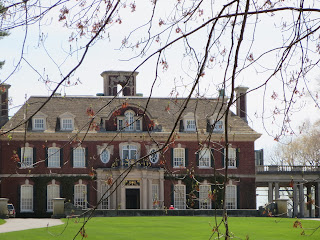 William Sidney Porter is much better known under his pen
name "O. Henry." He was born in
1862 in North Carolina and moved
to New York City in 1890 where over the next ten years before his death in
1910, he published over 300 stories and gained worldwide acclaim as America's
favorite short story writer. In New York
he rented a room at 55 Irving Place.
There was a tavern on the corner across
the street from O'Henry's room where
he did drink frequently.
William Sidney Porter is much better known under his pen
name "O. Henry." He was born in
1862 in North Carolina and moved
to New York City in 1890 where over the next ten years before his death in
1910, he published over 300 stories and gained worldwide acclaim as America's
favorite short story writer. In New York
he rented a room at 55 Irving Place.
There was a tavern on the corner across
the street from O'Henry's room where
he did drink frequently.
This tavern even
appeared in one of his stories, The Lost
Blend :" The saloon (whether blessed or cursed) stood in one of those
little "places" which are parallelograms instead of streets, and
inhabited by laundries, decayed Knickerbocker families and Bohemians who have nothing
to do with either."
 By the way there is a
scotch Whisky "The Lost Blend" with the name inspired by the story about life in a New
York bar featuring two business partners who try to recreate a blend of spirits
with close to supernatural properties.
By the way there is a
scotch Whisky "The Lost Blend" with the name inspired by the story about life in a New
York bar featuring two business partners who try to recreate a blend of spirits
with close to supernatural properties. Pete's Tavern is the oldest continuously operating restaurant and bar in New York City. In the beginning, and during the early development times of Gramercy Park, the building at 129 East 18th Street was the Portland Hotel - a local inn that provided rooms to residents and visitors to the area. In 1852, a grocery and grog shop opened on the first floor of the hotel. In 1864 the store was converted into saloon.
 A forty-foot, carved bar made of rosewood was installed atop
the black and white tiled floors. The bar area featured a few tables and large
wooden booths lined along the walls while the back dining room offered
additional booths and tables. Gas lamps, including an ornate chandelier that
hung over the cashier case, which remains to the right of the bar, lit the
entire tavern.
A forty-foot, carved bar made of rosewood was installed atop
the black and white tiled floors. The bar area featured a few tables and large
wooden booths lined along the walls while the back dining room offered
additional booths and tables. Gas lamps, including an ornate chandelier that
hung over the cashier case, which remains to the right of the bar, lit the
entire tavern. Cafe was bought in 1899 by Irish brothers Tom and John Healy, and became Healy's. In the early 1900s, it became a favorite of Tammany Hall politicians as their headquarters were located just a few blocks south on 14th street
During prohibition, when selling alcohol was illegal, the
bar continued to operate disguised as a flower shop.
O' Henry supposedly wrote The Gift of the Magi, sitting at one of the tables covered with red-and-white-checked cloths. The decor hasn’t changed and tavern is proud of its heritage. The name of the place was changed to Pete's when in Pete Belle purchased the bar in 1932.
The tavern atmosphere is superb and the sidewalk seats are
on one of Manhattan's more charming streets. Pete’s doesn’t so much cater to
the wealthy neighborhood dwellers it once did. It serves mostly as a place for
happy-hour drinks and NYU students who wander into it during their nightly pub
crawls. The beer selection isn’t extensive, but they do have a few Belgian and
German brews on tap for those interested in an outside-the-box option. The
prices are very reasonable- you can have
saloon Sandwiches served with cup of soup and potato salad for lunch for
10 dollars.O' Henry supposedly wrote The Gift of the Magi, sitting at one of the tables covered with red-and-white-checked cloths. The decor hasn’t changed and tavern is proud of its heritage. The name of the place was changed to Pete's when in Pete Belle purchased the bar in 1932.

















































